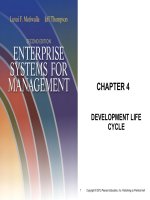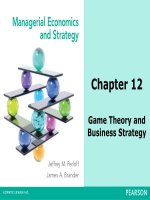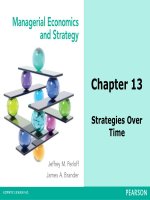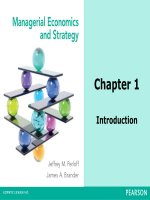Career development interventions 5th by spence niles and bowlsbey chapter 03
Bạn đang xem bản rút gọn của tài liệu. Xem và tải ngay bản đầy đủ của tài liệu tại đây (256.61 KB, 43 trang )
Career Development Interventions
5th Edition
Spence G. Niles and JoAnn E. Harris-Bowlsbey
Publisher to insert
cover image here
Chapter 3
Understanding and Applying
Emerging Theories of Career
Development
Developed by:
Jennifer Del Corso
Copyright © 2017, 2013, 2009 by Pearson Education, Inc. All Rights Reserved
Characteristics of Emerging
Theories
• Have evolved to address cognitive and meaningmaking processes that people use to manage
their career effectively within a global and
mobile society
• Attempt to address the career development
needs of diverse client populations
• Reflect a “postmodern” approach which stresses
the client’s subjective experience (stories rather
than scores)
Career Development Interventions, 5th Edition
Spencer G. Nile and JoAnn E. Harris-Bowlsbey
Copyright © 2017, 2013, 2009 by Pearson Education,
Inc.
All Rights Reserved
Lent, Brown, & Hackett’s Social
Cognitive Career Theory (SCCT)
• Builds on the assumption that cognitive
factors play an important role in career
development and decision making
• Is closely linked to Krumboltz’s learning
theory of career counseling
• Incorporates Bandura’s triadic reciprocal
model of causality
Career Development Interventions, 5th Edition
Spencer G. Nile and JoAnn E. Harris-Bowlsbey
Copyright © 2017, 2013, 2009 by Pearson Education,
Inc.
All Rights Reserved
Self-Efficacy (Bandura)
• Defined as people’s judgments of their
capabilities to organize and execute
courses of action required to attain
designated types of performances
Career Development Interventions, 5th Edition
Spencer G. Nile and JoAnn E. Harris-Bowlsbey
Copyright © 2017, 2013, 2009 by Pearson Education,
Inc.
All Rights Reserved
Forces Shaping Self-Efficacy
Beliefs (Bandura)
• Personal performance accomplishments
• Vicarious learning
• Social persuasion
• Physiological states and reactions
Career Development Interventions, 5th Edition
Spencer G. Nile and JoAnn E. Harris-Bowlsbey
Copyright © 2017, 2013, 2009 by Pearson Education,
Inc.
All Rights Reserved
Triadic Reciprocal Model
• The relationship among goals, self-efficacy, and
outcome expectations is complex
• This occurs within the framework of reciprocal
causality comprised of:
o personal attributes (e.g. predisposition, gender, race)
o external environmental factors (e.g., culture,
geography, family, gender-role socialization)
o learning experiences.
Career Development Interventions, 5th Edition
Spencer G. Nile and JoAnn E. Harris-Bowlsbey
Copyright © 2017, 2013, 2009 by Pearson Education,
Inc.
All Rights Reserved
SCCT Career Development
Interventions
• Directed toward
• self-efficacy beliefs
• outcome expectations
Career Development Interventions, 5th Edition
Spencer G. Nile and JoAnn E. Harris-Bowlsbey
Copyright © 2017, 2013, 2009 by Pearson Education,
Inc.
All Rights Reserved
Applying SCCT
• Card sort exercise in which clients sort occupations
according to:
• (a) those they would choose,
• (b) those they would not choose, and
• (c) those they question.
• Occupations placed in the first two categories
(relating to self-efficacy beliefs and outcome
expectations) are then examined for accuracy in skill
and outcome perceptions.
• Clients can be helped to modify their self-efficacy
beliefs by exposing them to personally relevant
vicarious learning opportunities
Career Development Interventions, 5th Edition
Spencer G. Nile and JoAnn E. Harris-Bowlsbey
Copyright © 2017, 2013, 2009 by Pearson Education,
Inc.
All Rights Reserved
Evaluating SCCT
• Overall SCCT has generated substantial
research supporting the efficacy of SCCTbased interventions for specific diverse
populations
• Choi, Park, Yang, Lee, and Lee (2012) found
that career decision-making self-efficacy
correlated significantly with self-esteem,
vocational identity, and outcome
expectations
Career Development Interventions, 5th Edition
Spencer G. Nile and JoAnn E. Harris-Bowlsbey
Copyright © 2017, 2013, 2009 by Pearson Education,
Inc.
All Rights Reserved
Four Assumptions of the Cognitive
Information Processing Approach (CIP)
• Career decision making involves the interaction
between cognitive and affective processes
• The capacity for career problem solving depends
on the availability of cognitive operations and
knowledge.
• Career development is ongoing and knowledge
structures continually evolve.
• Enhancing information processing skills is the
goal of career counseling
Career Development Interventions, 5th Edition
Spencer G. Nile and JoAnn E. Harris-Bowlsbey
Copyright © 2017, 2013, 2009 by Pearson Education,
Inc.
All Rights Reserved
CIP Approach
• The CIP approach to career intervention
includes several dimensions:
The pyramid of information processing,
CASVE cycle of decision-making skills, and
The executive processing domain.
Career Development Interventions, 5th Edition
Spencer G. Nile and JoAnn E. Harris-Bowlsbey
Copyright © 2017, 2013, 2009 by Pearson Education,
Inc.
All Rights Reserved
Information Processing
• Uses a pyramid to describe the domains of
cognition involved in a career choice:
self-knowledge
occupational knowledge
decision-making skills
• The fourth domain is metacognitions and
includes
self-talk
self-awareness
monitoring and control of cognitions
Career Development Interventions, 5th Edition
Spencer G. Nile and JoAnn E. Harris-Bowlsbey
Copyright © 2017, 2013, 2009 by Pearson Education,
Inc.
All Rights Reserved
CASVE Cycle
• This is the second dimension of the CIP
approach and represents a generic model of
information processing.
• Skills included are
C-communication
A-analysis
S-synthesis
V-valuing
E-execution
Career Development Interventions, 5th Edition
Spencer G. Nile and JoAnn E. Harris-Bowlsbey
Copyright © 2017, 2013, 2009 by Pearson Education,
Inc.
All Rights Reserved
Executive Processing Domain
• This domain involves metacognitive skills
such as self-talk, self-awareness, and
control.
Career Development Interventions, 5th Edition
Spencer G. Nile and JoAnn E. Harris-Bowlsbey
Copyright © 2017, 2013, 2009 by Pearson Education,
Inc.
All Rights Reserved
Applying the CIP Approach
• The CIP approach uses the Career Thoughts
Inventory (CTI) (Sampson, Peterson, Lenz,
Reardon, & Saunders, 1996) to identify clients
with dysfunctional career thoughts
• The pyramid model can be used as a framework
for providing career development.
• The five steps of the CASVE cycle can be used to
teach decision-making skills.
• The executive processing domain provides a
framework for exploring and challenging.
Career Development Interventions, 5th Edition
Spencer G. Nile and JoAnn E. Harris-Bowlsbey
Copyright © 2017, 2013, 2009 by Pearson Education,
Inc.
All Rights Reserved
Interventions (Peterson, Sampson,
& Reardon)
• Step 1 - Conduct initial interview with
client.
• Step 2 - Do a preliminary assessment to
determine the client’s readiness.
• Step 3 - Work with client to define the
career problem(s) and analyze causes.
• Step 4 - Collaborate with client to formulate
achievable problem-solving and decisionmaking goals.
Career Development Interventions, 5th Edition
Spencer G. Nile and JoAnn E. Harris-Bowlsbey
Copyright © 2017, 2013, 2009 by Pearson Education,
Inc.
All Rights Reserved
Sequence for Delivering Career
Interventions (Peterson, Sampson, &
Reardon)
• Step 5 - Provide clients with a list of
activities and resources they need
(individual learning plans).
• Step 6 - Require clients to execute their
individual learning plans.
• Step 7 - Conduct a summative review of
client progress and generalize new learning
to other career problems.
Career Development Interventions, 5th Edition
Spencer G. Nile and JoAnn E. Harris-Bowlsbey
Copyright © 2017, 2013, 2009 by Pearson Education,
Inc.
All Rights Reserved
Evaluating CIP
• Although research investigating CIP theory is not extensive,
the numbers of studies based on CIP theory is growing
• Successful use with military families coping with transitions
to new jobs
• Increased career decidedness, career planning, career
exploration, and vocational identity
• Higher levels of trauma in college students relate to
dysfunctional career thoughts, vocational identity, and
development work personality
• Students with disabilities have more negative thoughts than
nondisabled counterparts
Career Development Interventions, 5th Edition
Spencer G. Nile and JoAnn E. Harris-Bowlsbey
Copyright © 2017, 2013, 2009 by Pearson Education,
Inc.
All Rights Reserved
Savickas’ Career Construction
Theory
• Comprehensive career theory (explains
what, how, why)
• Career is socially constructed as individuals
implement their ideal self-concept as the
protagonist within their life story
Career Development Interventions, 5th Edition
Spencer G. Nile and JoAnn E. Harris-Bowlsbey
Copyright © 2017, 2013, 2009 by Pearson Education,
Inc.
All Rights Reserved
Career Construction Theory
• Vocational Personality (Self as Actor)
• Career Adaptability (Self as Agent)
• Life Themes (Self as Author)
Career Development Interventions, 5th Edition
Spencer G. Nile and JoAnn E. Harris-Bowlsbey
Copyright © 2017, 2013, 2009 by Pearson Education,
Inc.
All Rights Reserved
Vocational Personality
• • Vocational personality (Values, Abilities,
Traits reflect how a person’s narrates what
stage they would like to perform on, what
they believe they have the ability to do, and
what interests they have formed)
• • Holland’s Typology RIASEC reconceptualized as preferences and
possibilities, not predictions
Career Development Interventions, 5th Edition
Spencer G. Nile and JoAnn E. Harris-Bowlsbey
Copyright © 2017, 2013, 2009 by Pearson Education,
Inc.
All Rights Reserved
Career Adaptability
• Incorporates Super’s work
• Address the attitudes, beliefs, competences
(ABC’s) individuals need as they face career
transitions, work traumas, career decisionsboth anticipated and unanticipated
Career Development Interventions, 5th Edition
Spencer G. Nile and JoAnn E. Harris-Bowlsbey
Copyright © 2017, 2013, 2009 by Pearson Education,
Inc.
All Rights Reserved
Career Adaptability
(cont.)
• Concern
• Control
• Curiosity
• Confidence
Career Development Interventions, 5th Edition
Spencer G. Nile and JoAnn E. Harris-Bowlsbey
Copyright © 2017, 2013, 2009 by Pearson Education,
Inc.
All Rights Reserved
Life Themes
• Reoccurring themes throughout individuals
lives and work roles (e.g. helping others)
• Draws on narrative and how individuals
construct their experience
• Individuals are believed to “actively master
what they have passively suffered”
(Savickas, 2005)
Career Development Interventions, 5th Edition
Spencer G. Nile and JoAnn E. Harris-Bowlsbey
Copyright © 2017, 2013, 2009 by Pearson Education,
Inc.
All Rights Reserved
Career Construction Counseling
• Helps clients clarify and articulate the
private meanings they attach to their
career behavior- how they are striving
towards self-completion
• Utilizes the Career Construction Interview
(CCI) formerly known as the Career Style
Interview
Career Development Interventions, 5th Edition
Spencer G. Nile and JoAnn E. Harris-Bowlsbey
Copyright © 2017, 2013, 2009 by Pearson Education,
Inc.
All Rights Reserved









